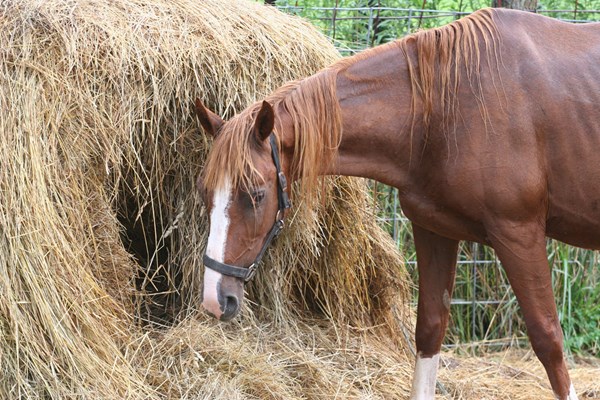 Credit: Thinkstock Feeding round bales at pasture is more likely to trigger equine asthma and is usually associated with more severe disease.
Credit: Thinkstock Feeding round bales at pasture is more likely to trigger equine asthma and is usually associated with more severe disease.Heaves or broken wind are terms used for decades to describe an allergic respiratory disease of mature to older horses manifested by increased breathing efforts at rest and chronic coughing.
Over 40 years ago, the German veterinarian H. Sasse used the term chronic obstructive pulmonary disease (COPD) to describe horses with heaves because of similarities with the human disease. However, our knowledge of respiratory diseases in people and horses has grown considerably since then, and it is now clear that heaves in horses is more similar to asthma in people rather than COPD.
Veterinarians and scientists prefer using the term “recurrent airway obstruction” (RAO) that implies the reversible nature of the disease once horses are turned out on grass pasture. Equine asthma is used to describe the state of airway hyperresponsiveness following inhalation of dust particles commonly found in barns. Such exposure is usually the result of feeding moldy hay. However, some horses present identical signs while being on pasture during the summer in response to high levels of grass molds and tree pollen.
Feeding round bales at pasture is more likely to trigger equine asthma and is usually associated with more severe disease. Molds are particularly abundant in moldy hay. However, it is important to note that the same types of molds are also present in good-quality hay, but in lower numbers. A genetic predisposition has also been shown in some breeds, such as Warmbloods and Lipizzaners.
The goals of therapy are to avoid exposure to dust and to treat lung irritation. The most effective way to avoid dust is by keeping asthmatic horses outdoors all the time and not feeding hay. Appropriate substitutes to hay and grass are complete pelleted feeds or hay cubes. If horses have to be housed in a barn, it is important to use low-dust feed and bedding. Wetting hay or steaming it will help reduce dust levels, however some very sensitive asthmatic horses may still show signs. Most asthmatic horses improve one to two weeks after being turned outside on pasture with no access to hay, but it may take one to two months for horses kept indoors to show the benefits from reduced dust levels. Horses that only improve partially after dust exposure has been reduced should benefit further from drug treatment.
Treatment with corticosteroids and bronchodilators help reduce lung irritation and hasten recovery. Oral or injectable drugs usually cost less than aerosol drugs. However, oral or injectable therapy may result in adverse effects. Albuterol, a commonly used bronchodilator, is not absorbed orally in horses, but is effective when given as aerosol, although the benefit is very short-lived (around one hour). Antihistamines may help some asthmatic horses, but most will eventually stop responding to treatment. Recently, we showed that feeding a supplement rich in omega-3 fatty acids helps asthmatic horses breathe better and stop coughing within two to four weeks.
Remember, horses evolved on earth as free roaming grazing animals. Modern use of horses dictated husbandry practices that are not ideal for the horse respiratory health. Asthmatic horses in particular will greatly benefit from returning to their ancestral environment.
You can contact Dr. Laurent L. Couetil, Director, Equine Research Programs, Purdue University College of Veterinary Medicine, at 765-494-8548 or email him atcouetil@purdue.edu.
Information provided by the University of Kentucky Gluck Equine Research Center’s Lloyd’s Equine Disease Quarterly.


